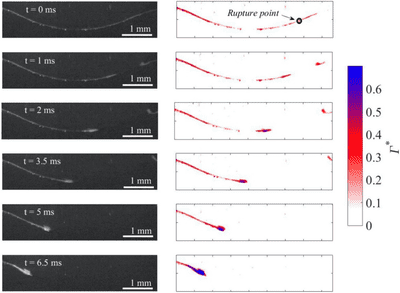Surfactant Transport at Interfaces
Fluids involved in multiphase flows usually include some additives due to technological requirements or contamination. They can be polymers, low molecular weight surfactants or nanoparticles. Many additives are surface-active, i.e. surfactants and they adsorb at fluid/liquid and solid/liquid interfaces and change interfacial properties including interfacial tension. They are often added to modify the drop or bubble size in dispersed flows which then increases the interfacial area in applications involving mass transfer between the phases, such as absorptions and reactions. Additionally, surfactants improve the stability of emulsions e.g. in cosmetics, food, pharmaceuticals.
The absorption of the surfactants at the interfaces is strongly dependent on the flow fields in the surrounding phases as well as thermodynamic properties. Surfactant adsorption is dynamic and the distribution at the interface can be non-uniform due to the hydrodynamics involved. Non-uniform surfactant distribution in turn results in additional stresses at the interface and Marangoni flows.
The transport of surfactants to and at developing liquid-liquid interfaces will be studied in this part of the project. The study will include adsorption kinetics of selected surfactants to provide kinetic coefficients and parameters of adsorption isotherm as input data for numerical studies. Experimental studies on formation and coalescence of surfactant-laden drops will be carried out and combined with Particle Image Velocimetry (PIV) and Ghost Particle Velocimetry (GPV) measurements of velocity fields. In addition to this, we will further develop the techniques for measuring dynamic interfacial tension in liquid-liquid mixtures. We will build on our previous work and will trace the concentration of fluorescent surfactants at evolving interfaces using a laser-induced fluorescence (LIF) technique.

The studies will be supported by extensive investigations of the flow fields in the two phases as interfaces develop. We will study the formation and coalescence of surfactant-laden drops. The results will be used to develop and validate surfactant transport predictions with numerical models, as well as theoretical considerations of Marangoni effects during interface breakup or coalescence.
